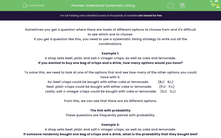Sometimes you get a question where there are loads of different options to choose from and it's difficult to see which one to choose.
If you get a question like this, you need to use a systematic listing strategy to write out all the combinations.
Example 1:
A shop sells beef, plain and salt n vineger crisps, as well as coke and lemonade.
If you wanted to buy one bag of crisps and a drink, how many options would you have?
To solve this, we need to look at one of the options first and see how many of the other options you could have with it.
So: beef crisps could be bought with either coke or lemonade. (B,C B,L)
Next: plain crisps could be bought with either coke or lemonade. (P,C P,L)
Lastly: salt n vinegar crisps could be bought with coke or lemonade. (S,C S,L)
From this, we can see that there are six different options.
The link with probability
These questions are frequently paired with probability.
Example 2:
A shop sells beef, plain and salt n vineger crisps, as well as coke and lemonade.
If someone randomly bought one bag of crisps and a drink, what is the probability that they bought beef crisps and a lemonade?
We know that there are six options in total and only one of these is the one we are looking for.
The probability will therefore be 1/6
Let's have a go at some questions.








